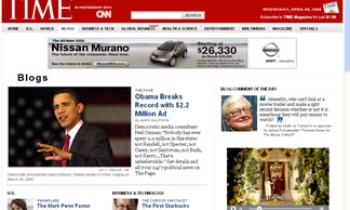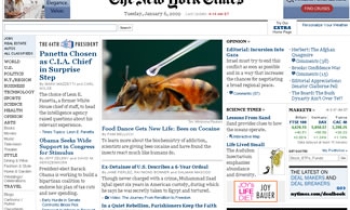Are you a Plum – a pregnant woman 35 or older – or do you think Pink, by making your career a lifestyle?
If you’re a business-owning, cookie-baking fashionista who lives in a bungalow and likes to spend the weekend traveling with your dog or container-gardening with your kids, there’s at least one magazine that caters to you.
Or more likely, a dozen.
And if you’re a man … well, there’s plenty for you, too.
More than 1,000 new titles were launched last year, including Men’s Vogue, Hollywood Dog and Poker Life.
By May of this year, nearly 300 more had hit the bookstore shelves, testing the waters of fickle consumerism, with Fertility Today, Real Fighter and Wine Adventure among them.
So many promising glossy pages. So little time.
More than half of them won’t survive their first year – in fact, 63 percent will die a public death, predicts Samir Husni, chair of the journalism department at the University of Mississippi.
With those numbers, it’s a wonder why anyone thinks they can launch a successful magazine.
“It’s the biggest ego trip,” Husni says, because you can be an editor or publisher from day one, without any journalistic experience whatsoever.
And you can rely on three major funding sources: “family, friends and fools.”
While improved technology and desktop publishing capabilities have made it easier for almost anyone to publish a magazine (or at least the first, and last, issue of a magazine), longevity is still a challenge.
“The gates for entry are getting wider and wider but survival is getting harder and harder,” he says.
“Anyone with $10,000 to $20,000 and a hole in their pocket can launch a magazine. The biggest problem is lack of knowledge about the business. If you’re lucky, after six months you might see a penny or two.”
It’s rare that a publisher can make money on a new launch during the first year, says Scott Moss, magazine marketing director for Dynamic Resource Group in Berne. The family-owned company publishes 15 magazines, including Simply Beads.
Most titles take three to five years to establish themselves and become financially stable, Moss says.
Husni gets inundated with calls from potential magazine publishers who want to run ideas by him. In 99.9 percent of the cases, he says the idea has been tried and abandoned before – and that’s why the magazine doesn’t exist.
Only 0.01 percent of callers have a truly genius idea that no one else has thought of yet, he says, laughing.
Last year, one of those was the independently owned Pink, the women’s business magazine that Husni labeled one of the top 30 launches of the year on his Web site www.mrmagazine.com.
Pink, celebrating its first anniversary, was launched as a bimonthly publication, but will produce seven issues this year. Cover profiles have included PepsiCo CEO Dawn Hudson and designer Kate Spade.
Its total circulation has increased from 100,000 to 115,000, proving that the magazine has struck a chord with women for its integration of career and life issues, marketing director Sara Beth Zivitz says.
Demographically, its target audience is women 27 to 55, with a median household income of $150,000 and higher, for whom “their career is a lifestyle,” whether they have to work or want to, she says.
“Think Fortune meets Oprah.”
Meanwhile, the title tweaks its nose at the idea of delicate femininity, Zivitz says.
While a few “naysayers” have criticized the girly label, it “sparks a dialog, which is good,” she says.
“Pink is all about redefining what it means to be a woman in the 21st century … it gives permission to be your authentic self in the workplace and not have to hide that.”
The magazine is successful, Husni says, because it added a new twist to the crowded field of women’s lifestyle magazines.
In that respect, it follows in the footsteps of other surprises such as Real Simple.
“Every single consultant and their cousin said (Real Simple) won’t make it,” Husni says, because it lacked those necessary staples of best-selling women’s magazines: sex and chocolate.
Now it’s one of the fastest growing women’s titles – but it’s still the exception to the rule.
“For every Real Simple, there are 100 ‘hard sophisticateds,’ ” he says.
There are titles for budding screenwriters, plastic surgery patients, doll collectors, Civil War buffs, ferret owners, vegetarians and arthritis suffers.
And there are at least 50 for scrapbooking, Husni says. He’s counted.
There’s probably more of the same on the way.
We’re inundated with options in cable TV channels, and easy access to blogs, thanks to the availability of wireless Internet in virtually every corner coffeehouse.
Yet we still love our magazines.
"Magazines are just a really vital part of the American cultural landscape. They're an economical way to satisfy people's desire for high-qualty, relevant, portable eye candy," Moss says.
"Magazines are both timely and timeless. They inspire, inform, educate and motivate," says Nina Link, CEO and president of Magazine Publishers of America.
"(They) are the original on-demand medium -- readers control when, where and how they consume magazines. And with today's media environment bursting with interruptive messages -- pop-ups, flashing banners, commercials, you name it -- magazines are an oasis," Link says in an e-mail.
Despite all the choices out there it’s still the predictable Cosmopolitan that tends to sell more newsstand copies than any other title, Husni says.
And why is that?
“We are creatures of habit. You’d really have to be living in space for the last 30 years that you don’t know what Cosmo is going to offer you this month.”
We do know what it offers – sex and chocolate – and we still buy it.
“It’s an addiction,” Husni says. “Magazines continue to be the best interactive laptops ever invented.”
He won’t make predictions on which of the magazines launched this year might make it.
“We (magazine publishers) are always dependent on readers, retailers, the U.S. Postal Service, advertisers. Our future is not in our hands. You can create the best magazine in the world, if readers don’t like it, you’re dead.”
But Husni will make this announcement: “Print is not dead. Print keeps on reinventing itself. As long as we have human beings … we’ll have magazines.”








